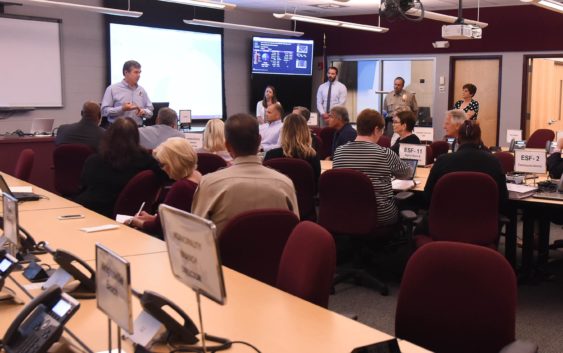- National memorial to honor NC firefighter who died on duty during Hurricane Helene
- Gov. Josh Stein extends State of Emergency for western NC wildfires
- Gov. Stein extends state of emergency for NC wildfire threat
- Governor Stein extends state of emergency for NC wildfire threat
- Governor Stein extends emergency in 34 NC counties amid wildfire threat
Learning lessons from Florence

Local officials reflect on the storm’s legacy
SOUTHEASTERN N.C. — Every hurricane, disaster situation is a learning experience.
So what do local officials say they learned from Hurricane Florence, a storm that uniquely hammered the Cape Fear region last September not with its raw power, but with its slow speed and torrential rains?
‘Develop a plan’
Brunswick County Commissioner Randy Thompson has seen many storms over the years. As the former emergency services director for Brunswick County, he understands the importance of preparedness.
When Florence first set her sights on the Carolinas, it was a dangerous Category 5 hurricane. As a result, those in the path prepared for catastrophic wind damage. Thompson said thankfully, the coast was spared.
“We got a lot of water, and we got a lot of water damage, but we didn’t get the wind damage that comes with a high-category hurricane,” he said.
But Florence was unique in that its winds slowed and it walked across the state, impacting the area for days. Thompson noted that Hurricane Michael, which hammered the Florida Panhandle, was much different. The storm moved quickly, but brought 140-mph winds and deadly storm surge.
After Michael, Thompson traveled to Florida to assist with recovery efforts. He recalled that the devastation from the two hurricanes was much different.
“Michael showed what a strong storm can do to property and the environment,” Thompson said.
He said though very different, the two storms highlighted the weak points in preparedness efforts, and officials can take that information and learn from it.
“It gives us perspective for the future,” he said.
Thompson said the most difficult part of storm response is assisting citizens after the hurricane.
“Recovery is tough,” he said. “It’s a very challenging, though part of the response.”
With the 2019 hurricane season officially underway, Thompson urges all citizens to begin preparing now.
“Develop a plan,” he said. “We all need a plan. My household has a plan.”
— Renee Spencer
Improving the re-entry process
Mayor Joe Benson of Carolina Beach said that the town did a good job in terms of getting a head start on the clean-up process after Hurricane Florence, but areas to improve upon are residents being prepared and the re-entry process.
“Readiness, it isn’t so much an efficient evacuation, it’s being prepared in the first place,” the mayor said.
Along with stocking up on supplies now, Benson said it’s also important for community members to have pre-selected primary and secondary evacuation sites before an evacuation order is mandated.
Benson said this hurricane season they hope to make the re-entry process more efficient to prevent people from prematurely returning to unlivable homes without basic services.
To allow businesses on the island to re-open sooner, Benson asks that the business owners identify employees that live in other places before the storm so they can be granted entry faster after the storm. The town has created a sticker, available at the Carolina Beach Town Hall, that residents can put on their windshield to identify them as residents of the island rather than having to keep track of a card.
He hopes the stickers will make re-entry into Carolina Beach more efficient.
— Julia Masters
‘Weeded out the weak ones’
Like many areas around the Cape Fear region, Wilmington saw record amounts of vegetative debris after Florence.
The city also saw lots of flooding, some occurring in areas where it normally doesn’t occur. In other places, the flooding was record-breaking.
City Councilman Charlie Rivenbark said Wilmington took its licks from Florence.
“We learn something every time a storm comes through,” he said. “This time, it was flooding — a high tide lifts all boats, and a lot of other stuff, too.”
As supervisor of Bellevue Cemetery, Rivenbark saw the impact of the storm’s floodwaters up close.
“This time I’m going to make sure our shipping container is strapped down, like a mobile home,” he said, referring to the impact of the rising waters at the historic Wilmington cemetery. “I didn’t think that a shipping container full of gear would float away, but it did.”
Like many parts of Southeastern N.C., the 32-acre cemetery also took a pounding from Florence’s persistent winds.
“We had 42 downed trees (at Bellevue), and I hope Florence weeded out the weak ones, so we won’t lose as many next time,” Rivenbark said.
— Ben Steelman
Contact the newsroom at 910-343-2384 or Breakingnews@StarNewsOnline.com.